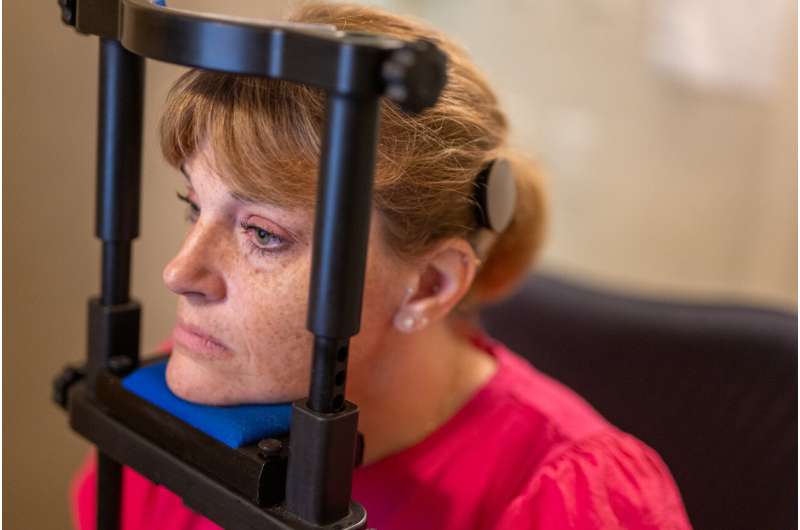This article has been reviewed according to Science X's editorial process and policies. Editors have highlighted the following attributes while ensuring the content's credibility:
fact-checked
peer-reviewed publication
trusted source
proofread
Cochlear implant users reveal basic approaches for how people recognize words

University of Iowa researchers have defined how people recognize words. In a new study with people who use cochlear implants to hear, the researchers identified three main approaches that people with or without hearing impairment use to recognize words, an essential building block for understanding spoken language. Which approach depends on the person, regardless of hearing aptitude or ability: Some wait a bit before identifying a word, while others may tussle between two or more words before deciding which word has been heard.
When a person hears a word, the brain briefly considers hundreds, if not thousands, of options and rules out most of them in less than a second. When someone hears "Hawkeyes," for example, the brain might briefly consider "hot dogs," "hawk," "hockey," and other similar-sounding words before settling on the target word.
While the brain operates quickly and differences in word-recognition strategies may be subtle, the findings in this study are important because they could open new ways for hearing specialists to identify word-recognition difficulties in early childhood or in older adults (who tend to lose hearing) and more effectively manage those conditions.
"With this study, we found people don't all work the same way, even at the level of how they recognize a single word," says Bob McMurray, F. Wendell Miller Professor in the Department of Psychological and Brain Sciences and the study's corresponding author. "People seem to adopt their own unique solutions to the challenge of recognizing words. There's not one way to be a language user. That's kind of wild when you think about it."
McMurray has been studying word recognition in children and in older adults for three decades. His research has shown differences in how people across all ages recognize spoken language. But those differences tended to be so slight that it made it difficult to precisely categorize. So, McMurray and his research team turned to people who use cochlear implants—devices used by the profoundly deaf or severely hard-of-hearing that bypass the normal pathways by which people hear, using electrodes to deliver sound.
"It's like replacing millions of hair cells and thousands of frequencies with 22 electrodes. It just smears everything together. But it works, because the brain can adapt," McMurray says.
The research team enlisted 101 participants from the Iowa Cochlear Implant Clinical Research Center at University of Iowa Health Care Medical Center. The participants listened through loudspeakers as a word was spoken, then selected among four images on a computer screen the one that matched the word they had heard. The hearing and selection activities were recorded with eye-tracking technology, which allowed the researchers to follow, in a fraction of a second, how and when each participant decided on a word they had heard.
The study is published in the journal Nature Communications.
The experiments revealed that the cochlear-implant users—even with a different way to hear—employed the same basic process when choosing spoken words as normal hearing people.
The researchers termed three word-recognition dimensions:
- Wait and See
- Sustained Activation
- Slow Activation
Most cochlear implant participants utilized Wait and See to some degree, the researchers found, meaning they waited for as much as a quarter of a second after hearing the word to firmly decide which word they heard.
Previous research in McMurray's lab has shown that children with early hearing loss have Wait and See tendencies, but this hasn't been observed more generally.
"Maybe it's a way for them to avoid a bunch of other word competitors in their heads," McMurray says. "They can kind of slow down and keep it simple."
The researchers also learned that some cochlear implant participants tended toward Sustained Activation, in which listeners tussle for a bit between words before settling on what they think is the word they heard, or they utilize Slow Activation, meaning they're slower to recognize words. Importantly, every listener seems to adopt a hybrid, with a different degree of each strategy.
The dimensions match the patterns by which people without hearing impairment, from youth to older ages, tend to recognize words, as shown in a previous study by McMurray's team.
"Now that we've identified the dimensions with our cochlear implant population, we can look at people without hearing impairment, and we see that the exact same dimensions apply," McMurray says. "What we see very clearly with how cochlear implant users recognize words is also going on under the hood in lots of people."
The researchers now hope to apply the findings to develop strategies that may help people who are at the extreme ends of a particular word-recognition dimension. About 15% of adults in the United States have hearing loss, which could cascade into cognitive decline, fewer social interactions, and greater isolation.
"We aim to have a more refined way than simply asking them, 'How well are you listening; do you struggle to perceive speech in the real world?'" McMurray says.
More information: Underlying dimensions of real-time word recognition in cochlear implant users, Nature Communications (2024). DOI: 10.1038/s41467-024-51514-3




















